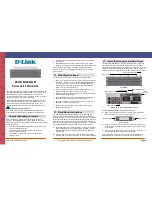
– 169 –
C
HAPTER
4
| Configuring the Switch
Link Layer Discovery Protocol
This network policy is potentially advertised and associated with
multiple sets of application types supported on a given port. The
application types specifically addressed are:
■
Voice
■
Guest Voice
■
Softphone Voice
■
Video Conferencing
■
Streaming Video
■
Control / Signaling (conditionally support a separate network policy
for the media types above)
A large network may support multiple VoIP policies across the entire
organization, and different policies per application type. LLDP-MED
allows multiple policies to be advertised per port, each corresponding to
a different application type. Different ports on the same Network
Connectivity Device may advertise different sets of policies, based on
the authenticated user identity or port configuration.
It should be noted that LLDP-MED is not intended to run on links other
than between Network Connectivity Devices and Endpoints, and
therefore does not need to advertise the multitude of network policies
that frequently run on an aggregated link interior to the LAN.
■
Policy ID – ID for the policy. This is auto generated and will be
used when selecting the polices that will be mapped to the specific
ports.
■
Application Type – Intended use of the application types:
■
Voice - For use by dedicated IP Telephony handsets and other
similar appliances supporting interactive voice services. These
devices are typically deployed on a separate VLAN for ease of
deployment and enhanced security by isolation from data
applications.
■
Voice Signaling (conditional) - For use in network topologies
that require a different policy for the voice signaling than for the
voice media. This application type should not be advertised if all
the same network policies apply as those advertised in the Voice
application policy.
■
Guest Voice - Support a separate 'limited feature-set' voice
service for guest users and visitors with their own IP Telephony
handsets and other similar appliances supporting interactive
voice services.
■
Guest Voice Signaling (conditional) - For use in network
topologies that require a different policy for the guest voice
signaling than for the guest voice media. This application type
should not be advertised if all the same network policies apply
as those advertised in the Guest Voice application policy.
■
Softphone Voice - For use by softphone applications on typical
data centric devices, such as PCs or laptops. This class of
Summary of Contents for EX26262
Page 1: ...Layer 2 Gigabit PoE Ethernet Switch Management Guide...
Page 2: ......
Page 3: ...MANAGEMENT GUIDE...
Page 4: ......
Page 6: ...6 ABOUT THIS GUIDE...
Page 18: ...18 FIGURES...
Page 20: ...20 TABLES...
Page 22: ...22 SECTION I Getting Started...
Page 34: ...34 SECTION II Web Configuration...
Page 46: ...46 CHAPTER 3 Using the Web Interface Navigating the Web Browser Interface...
Page 290: ...290 CHAPTER 5 Monitoring the Switch Displaying Information About Flow Sampling...
Page 294: ...CHAPTER 6 Performing Basic Diagnostics Running Cable Diagnostics 294...
Page 300: ...CHAPTER 7 Performing System Maintenance Managing Configuration Files 300...
Page 302: ...302 SECTION III Appendices...
Page 320: ...GLOSSARY 320...
Page 325: ......
Page 326: ......
















































